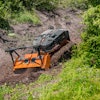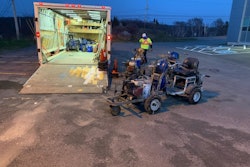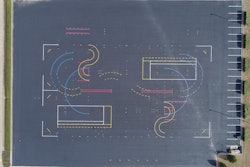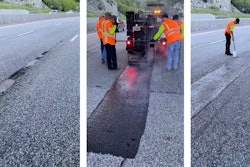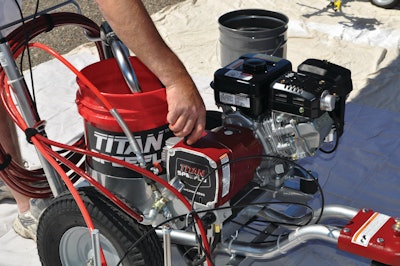
Cleaning striping equipment is an essential task contractors must complete to maintain quality equipment. From daily cleaning, to weekly maintenance, to regular and periodic cleaning contractors have various steps to follow to both preserve their equipment as well as ensure the application of a quality product.
By following these steps from Tom Heine, specialty business sales manager at TITAN, and David Villani of Ennis-Flint, contractors will find their equipment applying a higher quality product, operating more efficiently, and lasting significantly longer.
Some manufacturers suggest contractors clean their equipment daily while others have a unique daily, weekly and monthly maintenance plan. Regardless, it is essential that contractors properly clean their equipment to maintain quality equipment.
What you need. "Contractors need three 5-gallon buckets to start the cleaning process; one bucket with your coating, one bucket filled with water and one empty bucket for waste that is used to dump the recycled material back into it," Heine says. "To ensure proper cleaning, you want to siphon fresh water through the entire system into a separate waste bucket."
Contractors also need to use the proper cleaning solution based on the type of paint they used. "You should use warm, soapy water for latex based coatings, and mineral spirits/paint thinner for oil based coatings," Heine says. "There are many different coatings on the market today, use the appropriate cleaning agent that matches the coating being used." Another available solution by TITAN is Liquid Shield. This product is an additive to water, and it cleans and protects the spray system from rust and corrosion.
Cleaning the equipment. After having the proper solutions available, contractors can proceed to cleaning the equipment. "Essentially, you clean a paint sprayer the same way you spray," Heine says. "You basically flush the appropriate cleaning agent through the fluid section, hose(s), gun(s), and tip(s) until it’s clean.
“After following the proper pressure relief procedures (see manual), you want to remove the tip and tip guard from the gun, place the siphon tube into a bucket of clean water and the return hose into the waste bucket. Move the prime/spray valve to PRIME (wait 10 seconds), pull gun trigger against the side of the metal paint bucket (to reuse the coating), move prime/spray valve to SPRAY and slowly increase the psi until all of the coating is sprayed back into the coating bucket. Once the coating starts to thin out, you want to move the gun to the waste bucket and continue to spray until clear water or solvent is coming out of the gun.” Read owner’s manual for further detail.
According to Heine, after contractors run 5 gallons of water and then 5 gallons of water and Liquid Shield mixture through the equipment it will be cleaned.
After the excess product is taken from the equipment and stored in another container, contractors will need to remove various parts of the equipment. "At the end of each daily use, you need to remove the gun shrouds and fan caps from the air atomized equipment," Villani says. "You can clean those with soap and water for waterborne paints and either MEK or toluene for solvent based products."
Likewise for airless equipment, contractors also need to remove the tip(s) and tip guard cleaning them with a brush and using the appropriate cleaning agent. "If the paint is dried and soap and water may not clean it, use a mixture of 25 percent Methanol and 75 percent water to brush clean dried waterborne paint," Villani says.
Maintaining quality filters. Another important part of the equipment to clean is the filters. It is essential to clean the filters to avoid plugging the machine and losing pressure. Clean filters will also extend the pump life and keep the psi at an adequate level for spraying.
There are three filters that need to be cleaned on a line-striping machine. "There is a gun filter, a manifold filter and a rock catcher. The rock catcher is a filter on the bottom of the siphon tube," Heine says. "You pull out the filters and clean them with a bristle brush and cleaning agent."
Storing equipment. While some manufacturers suggest a daily deep cleaning of the equipment, others suggest cleaning select parts daily while imposing a weekly maintenance schedule. If following a weekly deep clean schedule, it is critical to properly store paint daily.
"For overnight storage of larger trucks, completely fill the paint tanks with paint," Villani says. "To prevent paint from drying on the surface pour ½ gallon of water on top of the paint after the truck has been parked. Check for skins on the paint in the tanks each day before starting, and if the skins are present be sure to remove them before turning on the agitators."
According to Villani, if using heat exchangers. "It is necessary to turn off the heated glycol to heat exchangers about 10 minutes prior to the daily shut down thus allowing paint to cool the exchange," Villani says.
If using heat exchangers contractors need to weekly flush water through the heated hoses, exchanger and out of the paint guns. They will also need to clean the strainer at the discharge end of the heat exchanger. This system should then be recharged with paint.
A few reminders. Contractors should be aware of several additional tips when running their striping equipment. "Never run tanks dry," Villani says. "An empty tank allows air into the system causing a 'tree ring effect' inside the plumbing. After this happens several times, the system will need to be torn down and completely cleaned."
Villani says contractors can prevent this from happening by reloading tanks and pumping paint through the entire system until it's full.
Properly cleaning striping equipment will help extend its life. "Cleaning the equipment helps prolong the life of the fluid section along with the guns, tips and hoses," Heine says. "Cleaning your equipment is a very important procedure, not doing so can lead to increased downtime and wasted labor, material, equipment and money.”



